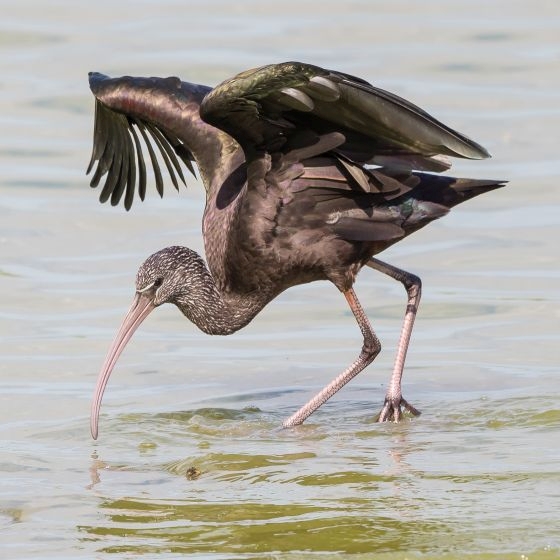Glossy Ibis
Plegadis falcinellus (Linnaeus, 1766)
IB
 GLOIB
GLOIB  1360
1360

Family: Pelecaniformes > Threskiornithidae

This rather smart bird, with its glossy green and purple-brown plumage, is not much bigger than a Curlew, something that surprises many encountering the species for the first time.
The Glossy Ibis has become more familiar to birdwatchers following a series of mass arrivals in the 2000s. Increasing numbers of reports since then mirror an increase in the breeding population located in the south-west of Europe. There have been a number of breeding attempts here, and it is likely that more regular breeding will be a feature in the future.
Climate change is thought to have supported the growth in visiting Glossy Ibis to Britain, with milder winters aiding their survival and enabling individuals to attempt breeding attempts the following year.
Identification
Glossy Ibis identification is usually straightforward.
SONGS AND CALLS
Listen to example recordings of the main vocalisations of Glossy Ibis, provided by xeno-canto contributors.
Flight call
Develop your bird ID skills with our training courses
Our interactive online courses are a great way to develop your bird identification skills, whether you're new to the hobby or a competent birder looking to hone your abilities.
Browse training coursesStatus and Trends
Population size and trends and patterns of distribution based on BTO surveys and atlases with data collected by BTO volunteers.
DISTRIBUTION
These maps show the distribution at the start of an invasion, a phenomenon that has continued, with individuals and small flocks of Glossy Ibises seemingly resident at several locations in southern Britain. Breeding seems likely in the coming years.
Occupied 10-km squares in UK
| No. occupied in winter | 28 |
| % occupied in winter | 0.9 |
European Distribution Map
DISTRIBUTION CHANGE
| % change in range in winter (1981–84 to 2007–11) | +733.3% |
SEASONALITY
Glossy Ibis was formerly a rare vagrant, but is now a scarce resident and potential breeder at many southern locations.

Movement
Information about movement and migration based on online bird portals (e.g. BirdTrack), Ringing schemes and tracking studies.
RINGING RECOVERIES
View a summary of recoveries in the Online Ringing Report.
Foreign locations of birds ringed or recovered in Britain & Ireland

Biology
Lifecycle and body size information about Glossy Ibis, including statistics on nesting, eggs and lifespan based on BTO ringing and nest recording data.
PRODUCTIVITY & NESTING
Sample sizes are too small to report Productivity and Nesting statistics for this species.
BIOMETRICS
Sample sizes are too small to report Biometrics for this species.
Feather measurements and photos on featherbase 
CODES & CLASSIFICATION
Field Codes 
|
2-letter: IB | 5-letter code: GLOIB | Euring: 1360 |
For information in another language (where available) click on a linked name
Would you like to search for another species?








Share this page